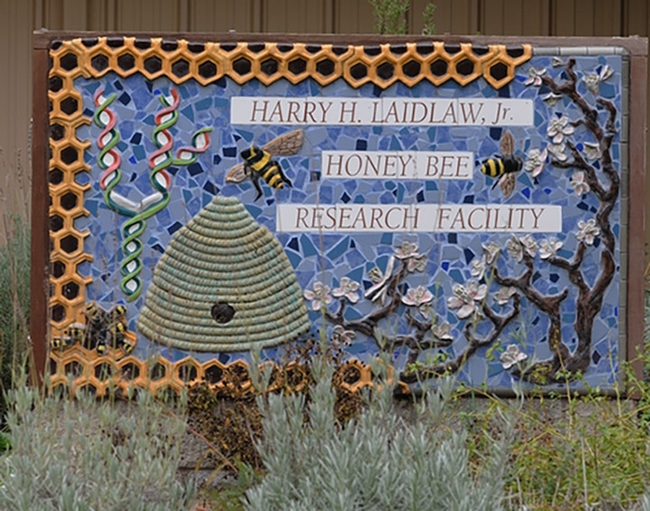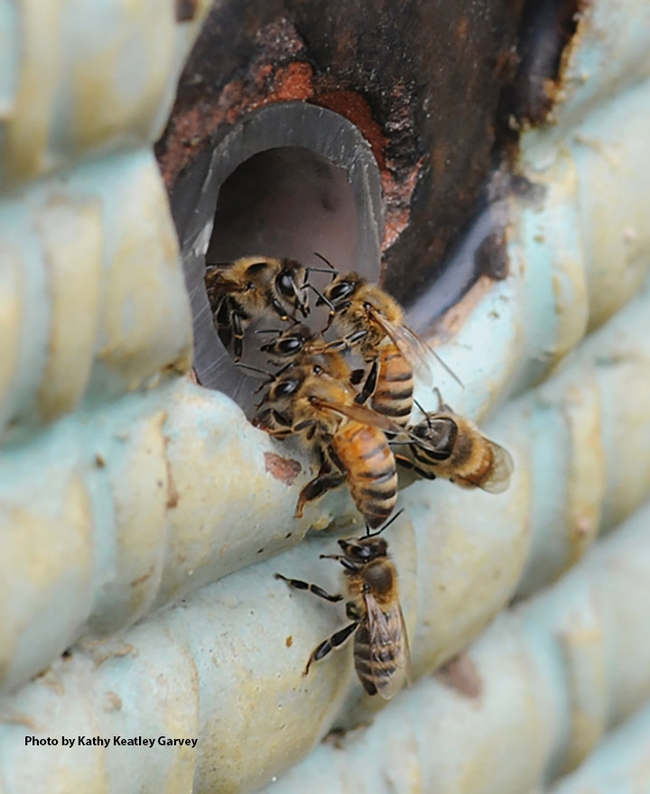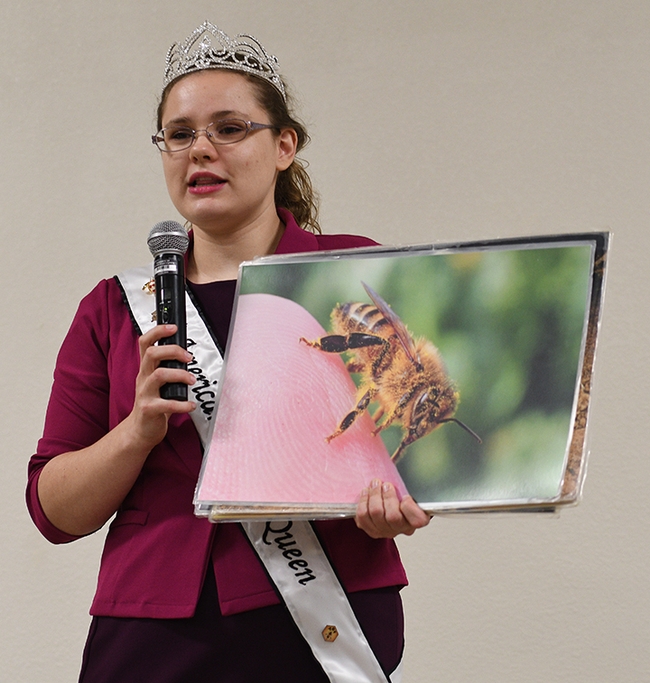- Author: Kathy Keatley Garvey
It was all the buzz.
Thousands of bee and honey enthusiasts made a beeline for the California Honey Festival, held last Saturday on the Yolo County Fairgrounds.
The annual festival, relocated this year from the streets of downtown Woodland to the fairgrounds due to a weather forecast cautioning heavy rain and wind, drew scores of smiles beneath the arched umbrellas.
Beekeeper Rick Moehrke, a retired Vacaville teacher, answered questions about bees in the Sacramento Area Beekeepers' Association booth.
American Honey Queen Kaelyn Sumner of Cecil, Wisc., a beekeeper and a senior at Kansas State University discussed queen bees, worker bees and drones. She is majoring in agricultural education and minoring in food science and entomology.
Charles McMaster, a U.S. Army veteran from Copperas Cove, Texas, headed the Hives for Heroes booth. The national non-profit service organization focuses on sustainability, conservation, and providing a healthy transition from service: "Through our national network of beekeepers, we provide connection, purpose, and healthy relationships, through access, resources, and funding for Active Duty, Veterans, and First Responders.">
Steve Hays, retired sheriff's deputy, Sacramento County and founder of Second Chance Beekeeping Reentry Service, chronicled the history of his program and how inmates are learning beekeeping and getting "a second chance." (See news story)

Amina Harris, retired founding director of the UC Davis Honey and Pollination Center and now the "Queen Bee" of her family's Woodland-based Z Food Specialty and The HIVE, offered guests "a taste of honey" from all over California. They also sold honey, including a family favorite, starthistle. Harris co-founded the California Honey Festival in 2017 with the City of Woodland.
Attendees tasted and purchased Hawaiian honey, with such varietals as Eucalyptus, macadamia, mango, Christmas bush, tropical blossom and wildflower, from "Queen Bee" Inna Eyrih, business owner of Hawaiian Honey AT&S, a company based in Hawaii (Keaau) and California.
GATEways horticulturist Rachel Davis of the UC Davis Arboretum and Public Garden discussed pollinator gardening, focusing on native bees, butterflies, moths, hoverflies, and hummingbirds.
This year's California Honey Festival lived up to its mission: to emphasize the importance of bees and to promote honey and bee products. The annual festival, co-sponsored by UC Davis, features educational presentations, kids' center activities, honey tasting, cooking demonstrations, a beer and mead garden, live music, vendors and more.
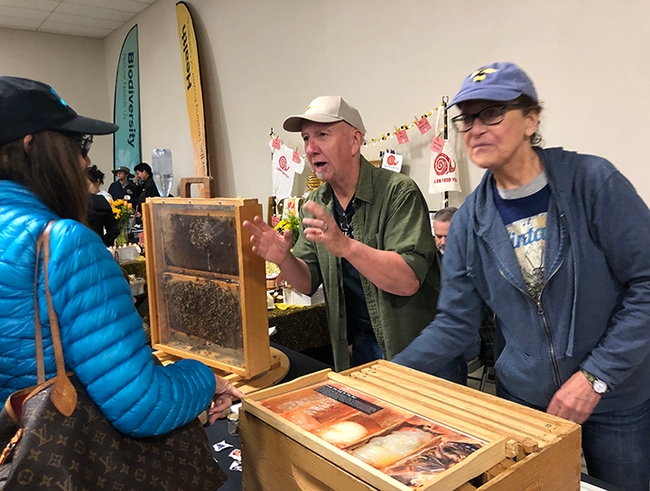
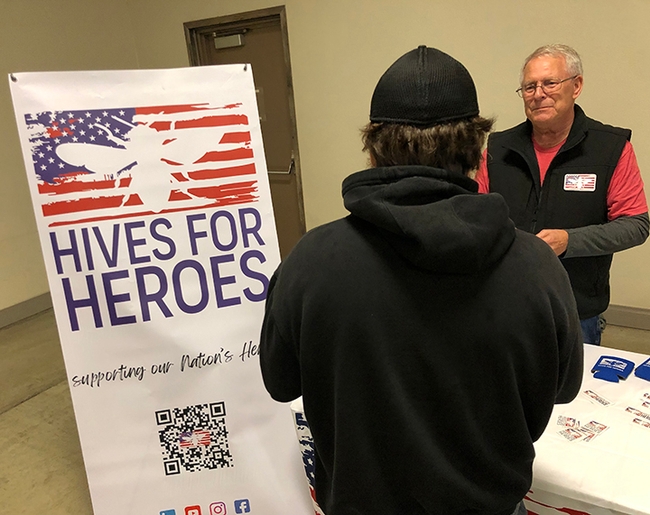
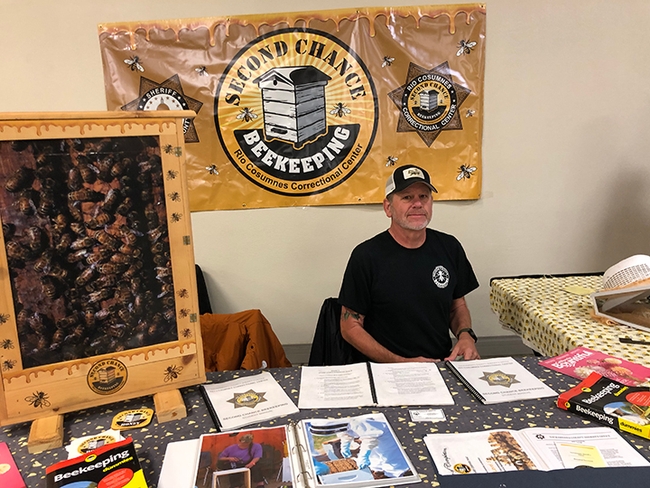
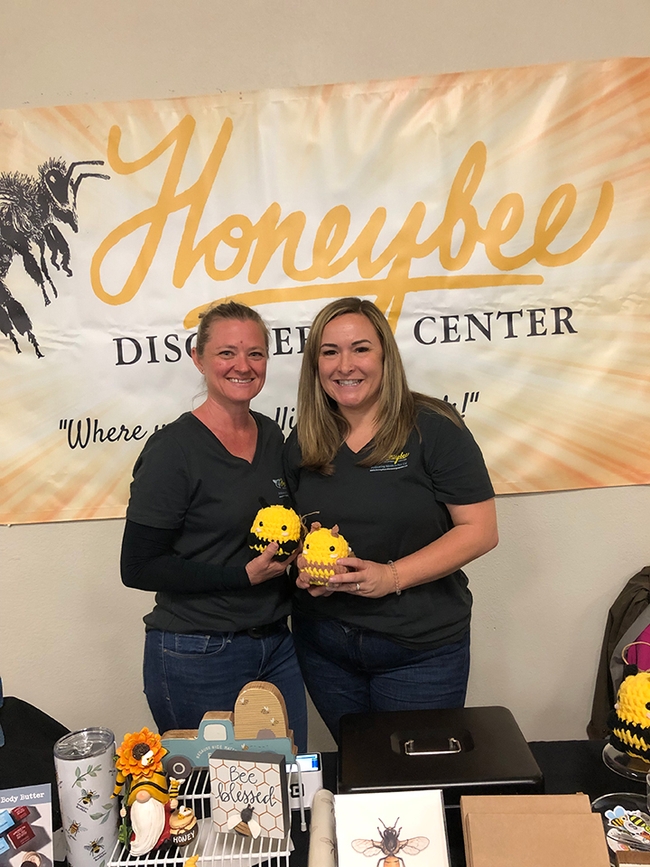
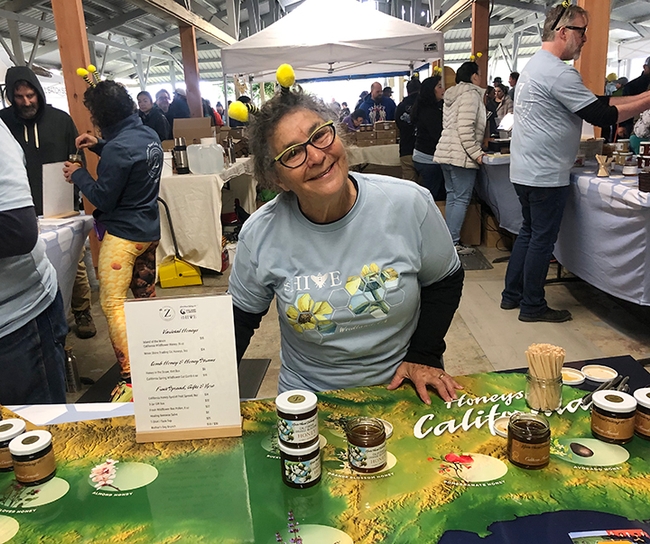

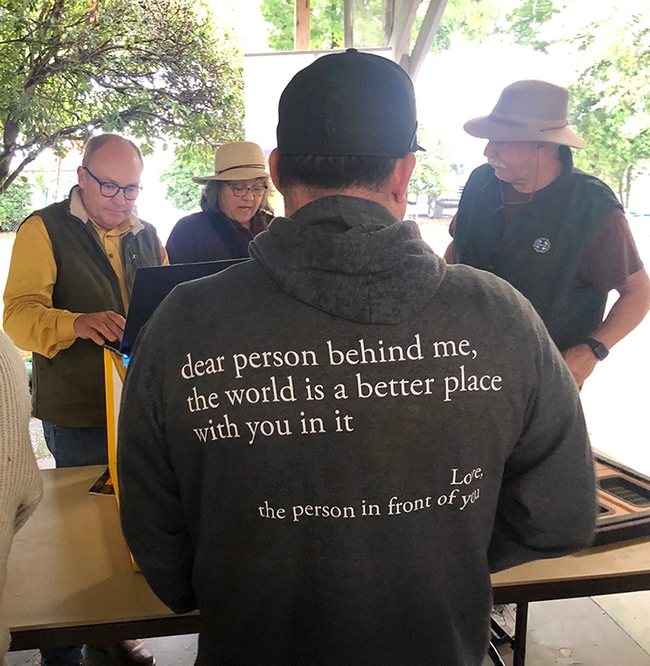
- Author: Kathy Keatley Garvey

The Celebration of Life and Legacy of UC Cooperative Extension apiculturist emeritus Eric Mussen, held Aug. 28 in the Putah Creek Lodge, UC Davis, drew a standing-room only crowd who shared and applauded the many facets of his life: family man, bee scientist, athlete, angler, birder, photographer, humorist and a singer (doo wop).
They all remembered that engaging smile, a smile that could melt frozen ice cream (a dessert he loved).
Members of California's beekeeping and almond industries--Team Eric--came out in force to honor their hero, their mentor, their confidant, their friend. Some traveled from as far away as Washington state and Idaho.
UC Davis distinguished professor Walter Leal live-streamed the event and posted it today on YouTube at https://youtu.be/Kj5NuQ_rBuo.
Dr. Mussen, who preferred to be called "Eric," was an internationally known 38-year Extension apiculturist and an invaluable member of the UC Davis Department of Entomology and Nematology faculty since 1976. He died Friday, June 3 in his Davis home at age 78 from aggressive liver cancer.
Although Eric retired in 2014, he continued his many activities until a few weeks prior to his death. For nearly four decades, he drew praise as “the honey bee guru,” “the pulse of the bee industry" and as "the go-to person" when consumers, scientists, researchers, students, and the news media sought answers about honey bees. Colleagues described him as the “premier authority on bees and pollination in California, and one of the top beekeeping authorities nationwide,” “a treasure to the beekeeping industry," and "a walking encyclopedia when it comes to honey bees.” Among who sought his expertise: The Lehrer Hour, BBC, Good Morning America, National Public Radio (Science Friday), The New York Times, Boston Globe, and The Los Angeles Times.
The Aug. 28th celebration opened with a welcome by Steve Nadler, professor and chair of the UC Davis Department of Entomology, who introduced Chancellor Gary May.
"Eric was a cherished friend to everyone here, to the UC Davis community, to his colleagues, to scientists and researchers, to agricultural growers and 4-H-ers, and to beekeepers and bee enthusiasts everywhere," the chancellor told the crowd. "He meant so much to the university and his work benefited us all. He represented the absolute best of UC Davis. He was an internationally recognized expert, dedicated to his work, and passionate about helping others and making the world a better place to be. His legacy will endure. It will endure through his research contributions and extension activities that served beekeeping operations across California and the nation. It will endure through the practices he helped put in place, sharing information with beekeeping groups. It will endure through the next generation of apiculturists he helped inspire. We'll remember his impact as the 'honey bee guru.' Much more than that, Eric will be remembered for his generosity, his kindness and his passion."
Emcee Gene Brandi, an icon in the bee industry and a family friend, served with Eric for 37 of his 39 years on the California State Beekeeping Association's Board of Directors. He currently chairs the Foundation for the Preservation of Honey Bees, Inc., and also served as president of American Beekeeping Federation and chaired both the California Apiary Board and National Honey Board.
One of Gene's many memorable comments: “To paraphrase a good friend of mine, (beekeeper) John Miller, “The people who really make a difference in this life are those who make things better. Eric Mussen made things better for the honey bee, beekeepers and the entire beekeeping industry and for that we are very grateful.”

There were scores of memorable comments from the speakers:
- Robert “Bob” Curtis, Carmichael, former director of Agricultural Affairs, Almond Board of California
- Ettamarie Peterson, veteran 4-H beekeeping project leader of the Liberty 4-H Club, Petaluma, a past president of the Sonoma County Beekeepers' Association, and a close friend of Eric's.
- Glenda Humiston, vice president of the UC Agriculture and Natural Resources, and Helene Dillard, dean of the UC Davis College of Agricultural and Environmental Sciences (virtual eulogies)
- Elina Lastro Niño, UC Extension apiculturist who also read the text of UC Davis emeritus professor Norman Gary, who was unable to attend
- Diane Ullman, professor and former chair of the Department of Entomology and Nematology
- Mary Lou Flint, an emeritis associate director of the UC Statewide Integrated Pest Management (UC IPM) Program, and an emeritus Extension entomologist, Department of Entomology and Nematology
- Walter Leal, UC Davis distinguished professor and former chair of the then Department of Entomology
- Michael Parrella, dean of the College of Agricultural and Life Sciences, University of Idaho, and a former chair of the Department of Entomology and Nematology
- And so many more...
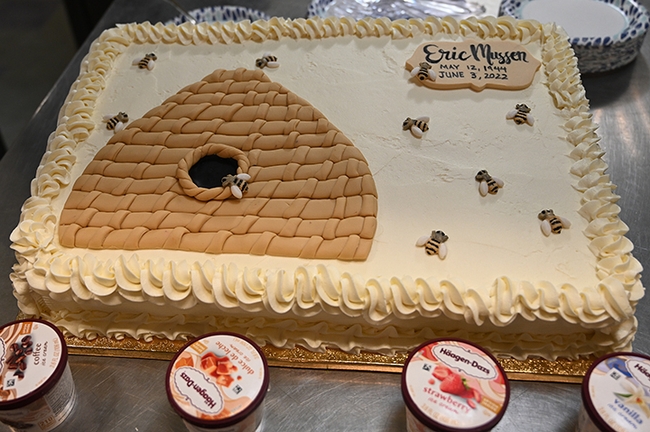
Adding to the celebration: a memory table from the Mussen family; bee pins to all the guests from the National Honey Board; a bee observation hive display from UC Extension apiculturist Elina Lastro Niño, director of the California Master Beekeeper Program (CAMPB), and Wendy Mather, program manager of CAMPB; honey straw donations from JoshuaZeldner, Amina Harris of Z Specialty Food, LLC; and ice cream donations from Haagen-Dazs (HD). Eric worked closely with HD especially during the colony collapse disorder phenomenon and the installation of the UC Davis Bee Haven on Bee Biology Road, UC Davis.
Olive and Vine of UC Davis catered the event. CreaTions N' Events of Sacramento provided a bee-themed cake, complete with a skep and honey bees.
"The world," said Dr. Leal, a former chair of the Department of Entomology who knew Eric well, "is a lesser place without Eric."
#EricStrong.
Eric is survived by his wife, Helen Mussen, sons Timothy Mussen (Noelle) of Rancho Cordova, and their children Amber and Alex; Christopher Mussen (Jacqueline Silva), of Davis; his younger brother Alan Mussen (Lynda) and their daughter, Allie and husband, Nick Arnold, all of Peru, N.Y.; and other relatives in New York and Michigan.
Memorial contributions may made to the California State 4-H Beekeeping Program, with a note, "Eric Mussen Memorial Fund." Checks may be be made out to:
California 4-H Foundation
Attn: Development Services (Eric Mussen Memorial Fund, California State 4-H Beekeeping Program)
2801 Second Street
Davis, CA 95618
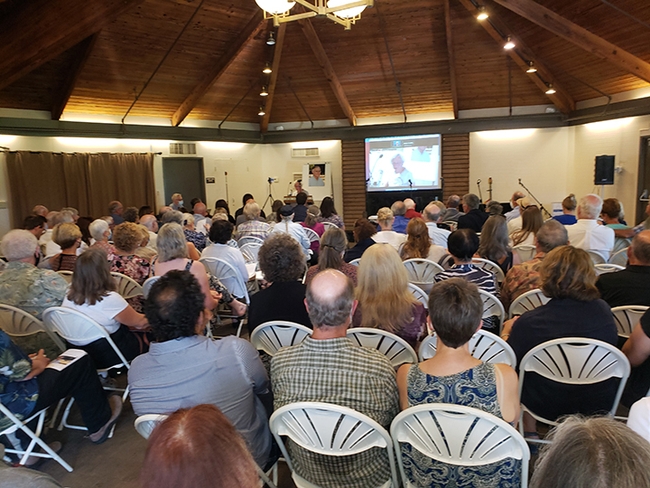
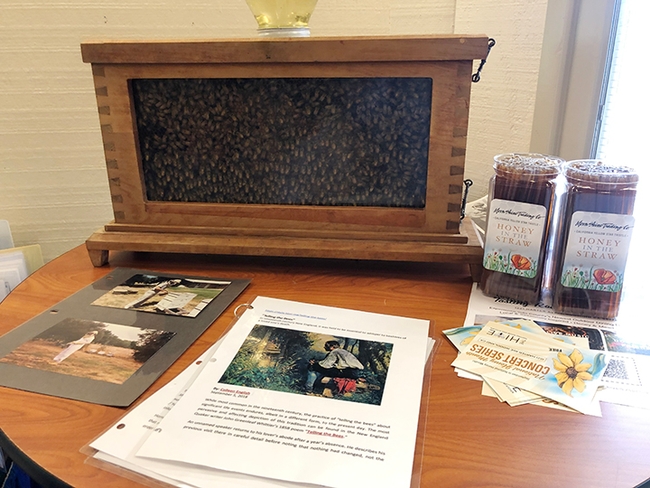
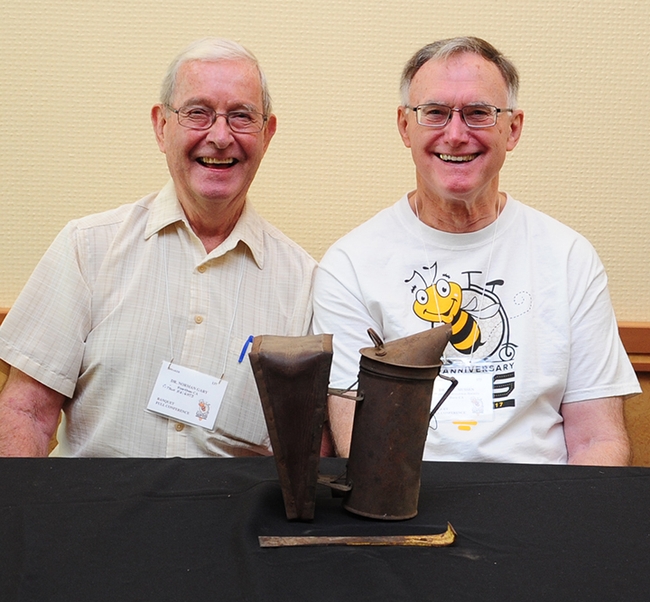
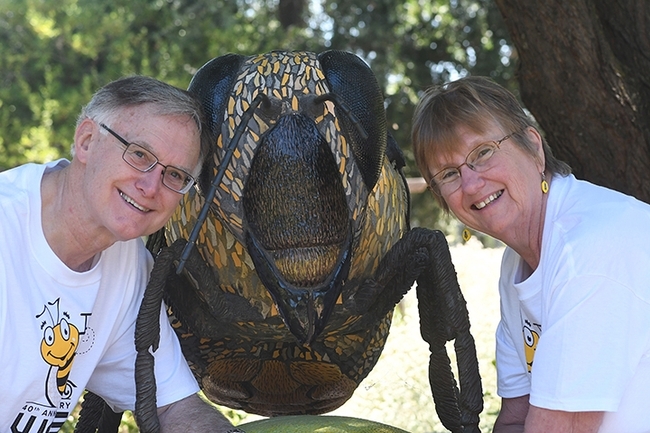
- Author: Kathy Keatley Garvey

And the yellow.
On a camping trip last week to Doran Regional Park, Bodega Bay, we admired our neighbors' display of American flags—bordered with a dozen honey bees.
These bees, however, didn't buzz. They spun.
The colorful yellow, black and white mobiles attacked the wind like fierce little windmills, livening up the campground.
“Are you beekeepers?” I asked the neighbor.
“No,” she replied. “We just like bees.”
So did George Washington (1732-1799), the founding father of our country.
Mount Vernon research historian Mary Thompson notes that George Washington was the first U.S. president to keep bees. In Washingtonpapers.org, she writes that his "indentured English joiner," Matthew Baldridge, received 300 nails at the Circle Storehouse on July 28, 1787 "to make a bee house."
"Two days later, Matthew received another 200 nails for the same project," Thompson notes. "In addition to getting honey from his own bees, George Washington is known to have purchased honey, as well as other foodstuffs such as chickens, eggs, vegetables, and fruit from his slaves. Honey, for example, was acquired at various times from Nat (a blacksmith); Davy, who was an enslaved overseer;and carpenters Sambo an Isaac, indicating that they, too, probably kept bees."
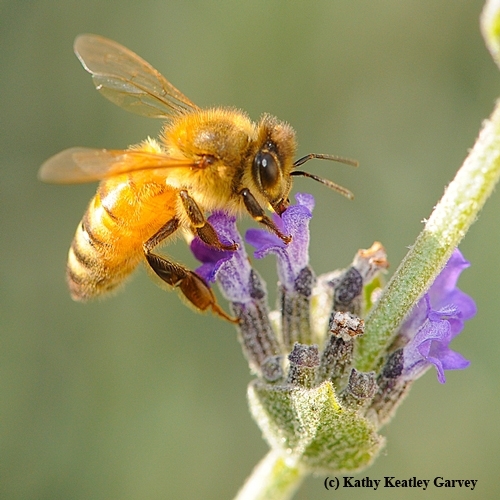
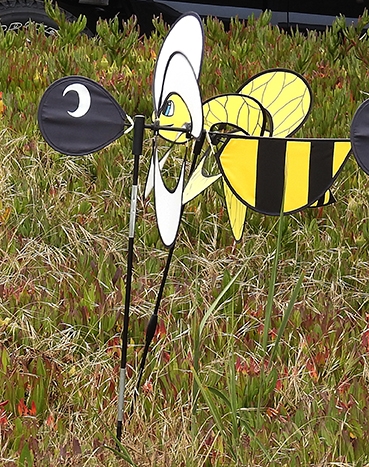
Thompson says President Washington also liked cake spread with honey and butter: "A visitor from Poland reported that Washington had “tea and caks (sic) made from maize; because of his teeth he makes slices spread with butter and honey….”
And, according to step-granddaughter Nelly Custis, Washington "ate three small mush cakes (Indian meal) swimming in butter and honey," and "drank three cups of tea without cream."
The founding father also liked gifts of honey. Knowing his fondness for honey, sister Betty Washington Lewis gifted him with a "large Pot of very fine in the Comb," when the president was recovering from a serious illness.
The Mount Vernon research historian also relates: "At the close of Washington's presidency eight years later, among the many things the family packed to ship back to Mount Vernon from Philadelphia was 'one demijohn with honey.' A demijohn was a very large glass bottle, covered with wickerwork."
Honey for the hoecakes, hoecakes swimming in honey...
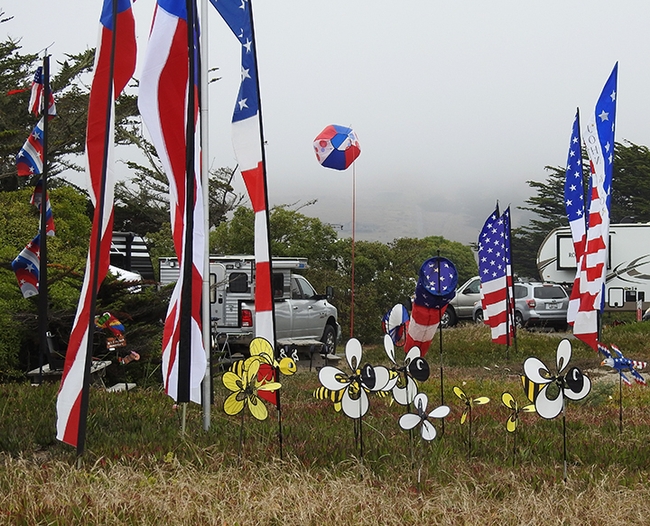
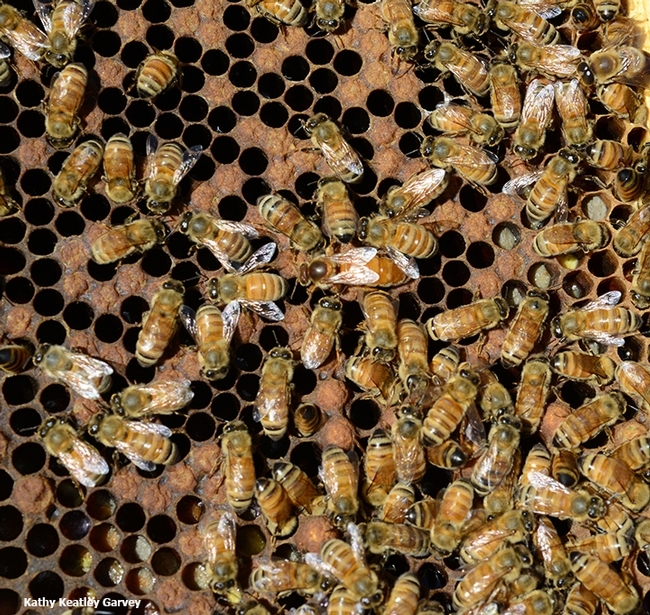
- Author: Kathy Keatley Garvey
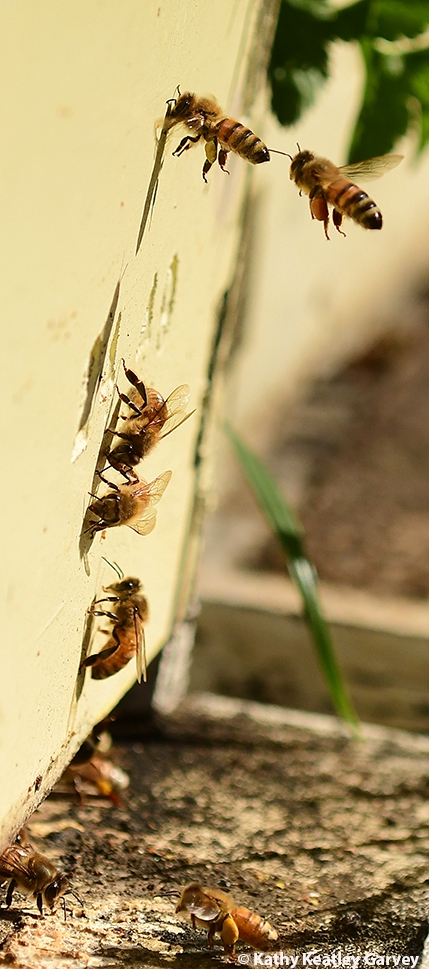
Of course, you go.
Almond pollination season is a delight to see and record. Almonds rank No. 2 among California's most valued agricultural commodities, right behind dairy products.
Sadly, glamour photographers often trespass on private property to take images of high fashion models in evening gowns and high heels, or to pose newly engaged couples and newlyweds. (One professional photographer even lists "40 poses for spring engagement photos in almond orchards.")
Apparently there's money to be made from the hard work of the farmers.
However, those of us born and raised on a farm appreciate the land, crops and farmers more than we do trespassing glamour photographers looking for a backdrop.
Almond pollination season ought to be about almond pollination.
Latest statistics from the U.S.Department of Agriculture's National Agricultural Statistics Services, show that "California's 2020 almond acreage at an estimated 1,600,000 acres, 5.3 percent higher than the 2019 acreage of 1,520,000. Of the total acreage for 2020, 1,250,000 acres were bearing, 5.9 percent above 2019, and 350,000 acres were non-bearing, up 2.9 percent from 2019. Preliminary bearing acreage for 2021 is estimated at 1,330,000 acres."
"Fresno, Kern, Stanislaus, Merced and Madera were the leading counties. These five counties accounted for 73% of the total bearing acreage."
Almond pollination season usually starts around Feb. 14 and ends around mid-March. Growers advocate two hives per acre. But since California doesn't have enough bees to pollinate the almonds, beekeepers truck their bees here from all over the United States. The Almond Board of California points out that "two-thirds of the nation's commercial honey bees hives converge in California."
This year almond growers and beekeepers faced frost ("cold snap"), rain, hail and a myriad of hive thefts. (In addition to trespassing photographers.)
Sadly, on our visit to an isolated Esparto almond orchard on Feb. 16, we not only saw the beginning of the almond pollination season, but the beginning of more work for the land owners--a discarded mattress, tossed potato chip bags, crumbled candy wrappers, broken beer bottles and other trash.
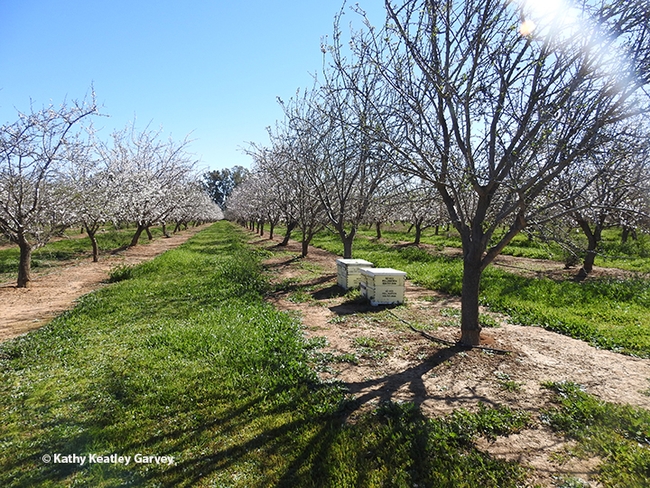
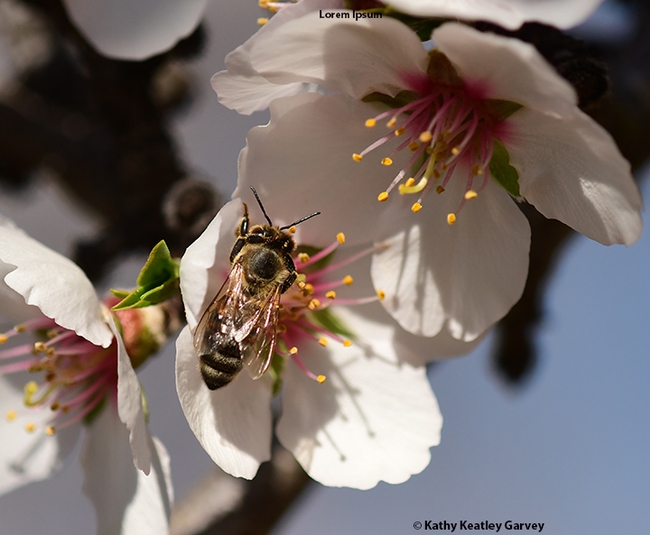
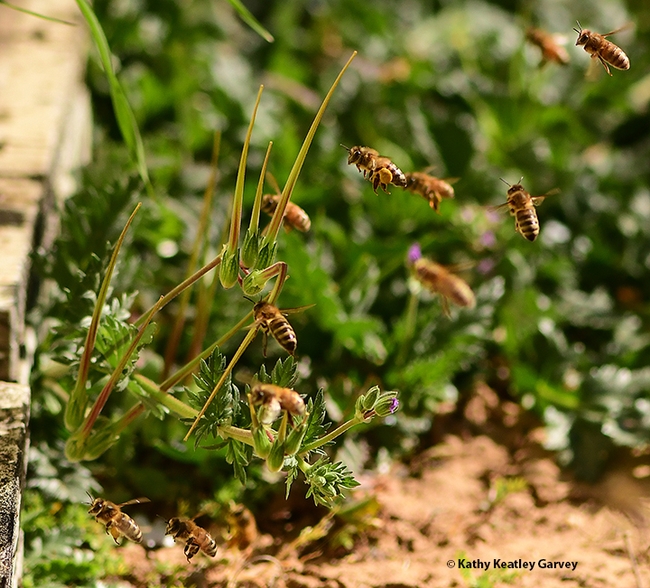
- Author: Kathy Keatley Garvey
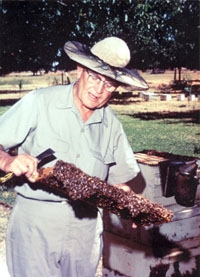
Let's pay special tribute to the servicemen and women who left the family farm to serve in our military. They were the farmers who fed the nation. And they became soldiers who defended our nation, much like guard bees defending their hives from intruders.
The late Harry Hyde Laidlaw Jr., (1907-2003), a noted professor at the University of California, Davis, was both a beekeeper and a military veteran. Harry spent his late boyhood and teen years in southeastern United States, working as a beekeeper with his grandfather. "Although he had never completed elementary school, he was able to enroll as a special student at Louisiana State University," according to a a UC memorial tribute. "In 1934 he completed a master's degree in entomology, and from there he went on to earn a Ph.D. in genetics and entomology from the University of Wisconsin in 1939."
Laidlaw went on to become renowned as "the father of honey bee genetics." (See his interview on Aggie Videos.)
But he was also an Army veteran. In 1942, he was inducted into the U.S. Army, commissioned, and served as the Army entomologist for the First Service Command in Boston, Mass. "He didn't see any war action, but I think he fought mosquitors on a base in Newfoundland," remembers his daughter Barbara Laidlaw Murphy. "Later he was stationed in Boston and that's how he met my mother. He stayed in the reserves and rose to the rank of lieutenant colonel."
If you visit the UC Davis bee biology facility, the Harry H. Laidlaw Jr. Honey Bee Research Facility located on Bee Biology Road, west of the central campus, you'll see a sign memorializing him. The sign, the work of Davis-based artist Donna Billick, creatively includes a hole in the skep for bees to tunnel to a hive located in back. For years we saw bees entering with pollen, leaving to get more, and guard bees on duty. Due to liability issues, the hive is no longer there, but there are plenty of hives in the apiary behind the building.
Bees and veterans go well together. Take the Hives for Heroes, a national, non-profit organization founded in 2018 in Houston, Texas, to help America's military veterans by getting them involved in beekeeping. Hives for Heroes focuses on honey bee conservation, suicide prevention, and a healthy transition from service. As their website says: "As a 501(c)3, Hives for Heroes gives back to veterans looking to start their beekeeping journey. Our organization is run by volunteers looking to serve those veterans who have selflessly served our country."
Our military veterans guarded and defended our nation. Now, in caring for their colonies in their newly acquired beekeeping roles, they can watch bees guard and defend their hives.
